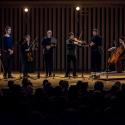It stunned me to discover that last night was only the sixth time Carmina Burana had been heard at the Proms. It seems tailor-made for the festival: large-scale and bombastic in a way that fits the proportions of the Albert Hall, familiar to occasional concert-goers but with much more to it than the "famous bit". And in this performance the CBSO and an array of choirs went at it with gusto, raising the audience to its feet at the end. Carmina Burana may be an utterly manipulative piece – knowing the buttons to press and pressing them shamelessly – but it is a pleasure sometimes to be manipulated, and I bounced out of the hall as if emerging from a Thai massage.
But first there was Stravinsky’s Symphony of Psalms. This is for me a Desert Island piece which I love beyond description, but I don’t think I would have fallen for it if that was the first time I had heard it. There are many connections between the Symphony and Carmina Burana that make them a good pairing (I don’t know if Orff knew the Stravinsky). In particular the wind-heavy scoring and use of two pianos make for a comparable timbre.
But on the night the Stravinsky didn’t really take-off: the opening tempo seemed tentative, co-ordination a bit approximate with the choir seeming to hold things back, despite the clear beat of conductor Kazuki Yamada (pictured above by Sisi Burn). There were some lovely brass entries in the second-movement fugue, but only in the ineffable last few minutes, with the choir’s rotating phrases surrounded by a halo-like wind chord, did I get a glimpse of the true magic of the piece.But then after the interval it was a different story. There was a vigour I had previously missed, there was excellent ensemble and everything had a bite and sense of intent. There’s a reason the opening has launched a thousand TV shows: it is utterly brilliant. Timpanist Matthew Hardy beat the hell out of his drums, the trombones gave it everything, and Yamada stood at the centre, driving the whole thing forward. Carmina Burana is not subtle in its musical means – pounding ostinatos, simple diatonic phrases in the voices, strophic sections where we hear the same music several time – but the CBSO and choirs were persuasive salesmen. The massed choir, comprising the CBSO Chorus, Youth and Children’s Choruses as well as the University of Birmingham Voices, were lusty and lively, and they enjoyed the back and forth with soloists Maki Mori and Germán Olvera (pictured above).
Carmina Burana is not subtle in its musical means – pounding ostinatos, simple diatonic phrases in the voices, strophic sections where we hear the same music several time – but the CBSO and choirs were persuasive salesmen. The massed choir, comprising the CBSO Chorus, Youth and Children’s Choruses as well as the University of Birmingham Voices, were lusty and lively, and they enjoyed the back and forth with soloists Maki Mori and Germán Olvera (pictured above).
In particular there was fun to be had with the roasting swan, countertenor Matthias Rexroth standing in as a last-minute replacement. There are few lyrical moments, but Mori was delicious in “In Trutina” – and then astonishing in the orbital heights of “Dulcissime”. Yamada paced things nicely as we headed to the ecstatic end of “Ave formosissima” before the return of the opening “O Fortuna”, as guaranteed to draw a standing ovation as any single passage of music.














Add comment